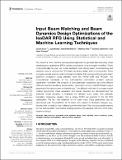Files in this item
Input beam matching and beam dynamics design optimizations of the IsoDAR RFQ using statistical and machine learning techniques
Item metadata
| dc.contributor.author | Koser, Daniel | |
| dc.contributor.author | Waites, Loyd | |
| dc.contributor.author | Winklehner, Daniel | |
| dc.contributor.author | Frey, Matthias | |
| dc.contributor.author | Adelmann, Andreas | |
| dc.contributor.author | Conrad, Janet | |
| dc.date.accessioned | 2022-05-11T15:30:21Z | |
| dc.date.available | 2022-05-11T15:30:21Z | |
| dc.date.issued | 2022-04-25 | |
| dc.identifier | 279547532 | |
| dc.identifier | 6d7040e5-8858-4d45-bb9c-9aa3d44fdb08 | |
| dc.identifier | 85129789619 | |
| dc.identifier.citation | Koser , D , Waites , L , Winklehner , D , Frey , M , Adelmann , A & Conrad , J 2022 , ' Input beam matching and beam dynamics design optimizations of the IsoDAR RFQ using statistical and machine learning techniques ' , Frontiers in Physics , vol. 10 , 875889 . https://doi.org/10.3389/fphy.2022.875889 | en |
| dc.identifier.issn | 2296-424X | |
| dc.identifier.other | Jisc: 300697 | |
| dc.identifier.other | publisher-id: 875889 | |
| dc.identifier.other | ORCID: /0000-0002-7842-0051/work/113061428 | |
| dc.identifier.uri | https://hdl.handle.net/10023/25344 | |
| dc.description | This work was supported by NSF grants PHY-1505858 and PHY-1626069 and funding from the Bose Foundation and the Heising-Simons Foundation. | en |
| dc.description.abstract | We present a novel machine learning-based approach to generate fast-executing virtual radiofrequency quadrupole (RFQ) particle accelerators using surrogate modelling. These could potentially be used as on-line feedback tools during beam commissioning and operation, and to optimize the RFQ beam dynamics design prior to construction. Since surrogate models execute orders of magnitude faster than corresponding physics beam dynamics simulations using standard tools like PARMTEQM and RFQGen, the computational complexity of the multi-objective optimization problem reduces significantly. Ultimately, this presents a computationally inexpensive and time efficient method to perform sensitivity studies and an optimization of the crucial RFQ beam output parameters like transmission and emittances. Two different methods of surrogate model creation (polynomial chaos expansion and neural networks) are discussed and the achieved model accuracy is evaluated for different study cases with gradually increasing complexity, ranging from a simple FODO cell example to the full RFQ optimization. We find that variations of the beam input Twiss parameters can be reproduced well. The prediction of the beam with respect to hardware changes, e.g., the electrode modulation, are challenging on the other hand. We discuss possible reasons for that and elucidate nevertheless existing benefits of the applied method to RFQ beam dynamics design. | |
| dc.format.extent | 10 | |
| dc.format.extent | 1852619 | |
| dc.language.iso | eng | |
| dc.relation.ispartof | Frontiers in Physics | en |
| dc.subject | Physics | en |
| dc.subject | Radio frequency quadrupole | en |
| dc.subject | Beam dynamics design | en |
| dc.subject | Beam matching | en |
| dc.subject | Virtual accelerator | en |
| dc.subject | Isodar | en |
| dc.subject | Surrogate modelling | en |
| dc.subject | Neural network | en |
| dc.subject | Polynomial chaos expansion | en |
| dc.subject | QA75 Electronic computers. Computer science | en |
| dc.subject | QC Physics | en |
| dc.subject | NDAS | en |
| dc.subject.lcc | QA75 | en |
| dc.subject.lcc | QC | en |
| dc.title | Input beam matching and beam dynamics design optimizations of the IsoDAR RFQ using statistical and machine learning techniques | en |
| dc.type | Journal article | en |
| dc.contributor.institution | University of St Andrews. Applied Mathematics | en |
| dc.identifier.doi | 10.3389/fphy.2022.875889 | |
| dc.description.status | Peer reviewed | en |
This item appears in the following Collection(s)
Items in the St Andrews Research Repository are protected by copyright, with all rights reserved, unless otherwise indicated.

